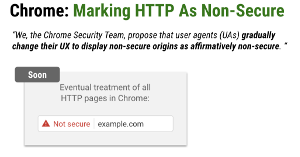
3 Marketing Reasons to Move from HTTP to HTTPS
With even major sites dragging their feet to make the move from HTTP to HTTPS, major players like Google, Amazon, and LinkedIn are starting to penalize sites for failing to do so.
Haven’t made the move from HTTP to HTTPS yet? You’re not alone, but it’s time.
The good news is that over one-third of the top 1 million websites use SSL by default, an increase of 150% in the last year, according to BuiltWith. The bad news? That still leaves two thirds of the top websites using a less secure protocol.
But now, Google is putting pressure on websites by flagging all sites that are not encrypted with HTTPS as “not secure” in the Chrome web browser. The longer we put off the shift from HTTP to HTTPS, the more our marketing efforts will suffer if our websites are not secure.
What is HTTPS and Do You Already Use It?
Hyper Text Transfer Protocol Secure (HTTPS) is the secure version of HTTP (Hyper Text Transfer Protocol) and allows for secure communication of user information, as Google states “protecting the integrity and confidentiality of data between the user’s computer and the site.” The secure connection protects the privacy and integrity of the exchange of data.
To quickly check if your site uses HTTPS, navigate to your site on the Google Chrome browser and look for a closed padlock next to the URL with “Secure” to the left of the icon.

If your site doesn’t use HTTPs, it will be passively marked as not secure with an information icon next to the URL, and actively marked as “not secure” once the user enters information in any field on the page.

Making the Case to Change
We have been warned for years but maybe we just haven’t had the time to make it a priority, as we focus on website improvements and other marketing channels that impact our business objectives. Here are three ways moving from HTTP to HTTPS can help your marketing efforts.
1. Ensure Strength (or, Prevent Decline) in Google Organic Search Rankings
Steady ranking and improvement in Google organic search results is the most well known marketing benefit of switching to HTTPS. Let’s bring some facts and stats to support this claim.
Brightedge reports that 51% of all trackable traffic in 2017 came from organic search. Google owns 91% of all organic search traffic, and in 2014, Google announced that HTTPS would be a factor in SERP rankings. In 2015, Google announced that it would index HTTPS websites by default.
In short, the sooner you make the change, the sooner you should start to see an uptick in your organic search traffic.
2. Ad Platforms Rejecting Non-HTTPS Landing Pages
Advertising providers are becoming more sophisticated about protecting user data. More and more, advertising delivery platforms require that landing pages — particularly those that support the transfer of user data (like form submissions) — live within a secure domain. Google’s advertising policy requires HTTPS for any ad destinations that collect data. LinkedIn requires HTTPS landing pages for all formats (even Lead Gen Forms), and Amazon and AdRoll also now require HTTPS.
Failing to move to HTTPS could cause ads to be rejected, potentially creating a major delay in your campaign schedules and prevent you from achieving your marketing goals.
Bonus: Impact on Analytics
Keep in mind that you also shouldn’t treat your landing pages differently than your main websites, just for the sake of getting your ads approved. Taking this one step further to your analytics — Moz recently identified an important analytics distinction regarding HTTPS. If a user travels from a secure HTTPS webpage to a non-secure HTTP webpage, the referral data is lost and this transfer is considered direct traffic. If you are still on HTTP, you may see your referral traffic decreasing with your direct traffic increasing.
Losing this referral data is a hit on your visitor analysis, as you work to evaluate the holistic digital journey of your consumers.
3. Consumer Perception
In general, web users are becoming more savvy. And with policies like the EU’s imminent General Data Protection Regulation (GDPR) approaching this year (within which moving to HTTPS is also a technical must), consumers are becoming more educated about the transfer, use, and storage of their data.
Google is also educating on the importance of a security browsing experience. Google Chrome owns 59% of browser market share, and now makes it VERY clear to the user if the website they are visiting is secure, or not, directly next to the URL.

Source: https://blog.ezoic.com/preparing-google-algorithm-changes-2018/
Soon, we may even see this Secure vs. not Secure delineations right in SERP results.
Website visitors see this “warning” and raise their hand, questioning the security of their personal data. But, with these warnings positioned even before the user visits the website, will we risk losing their website visit altogether?
Seeing the little “s” in URLs gives your consumers enough confidence in your website and ultimately, your brand.
How to Enable HTTPS on Your Site
To enable HTTPS, you must obtain a SSL Certificate and install it on your server. Then make sure to set up automatic 301 redirects to prevent any broken links from HTTP to HTTPS, and then you’ll want to regenerate your XML sitemap and resubmit to Google Search Console (webmaster tools) to speed up the indexing process. Even though the redirects are in place, you’ll want to update any links on public profiles or social media accounts.
Then, monitor and conduct an SSL test, just in case, as you should treat this as a site migration. Google provides more insight on why HTTPS matters as well as transparency around its global adoption.